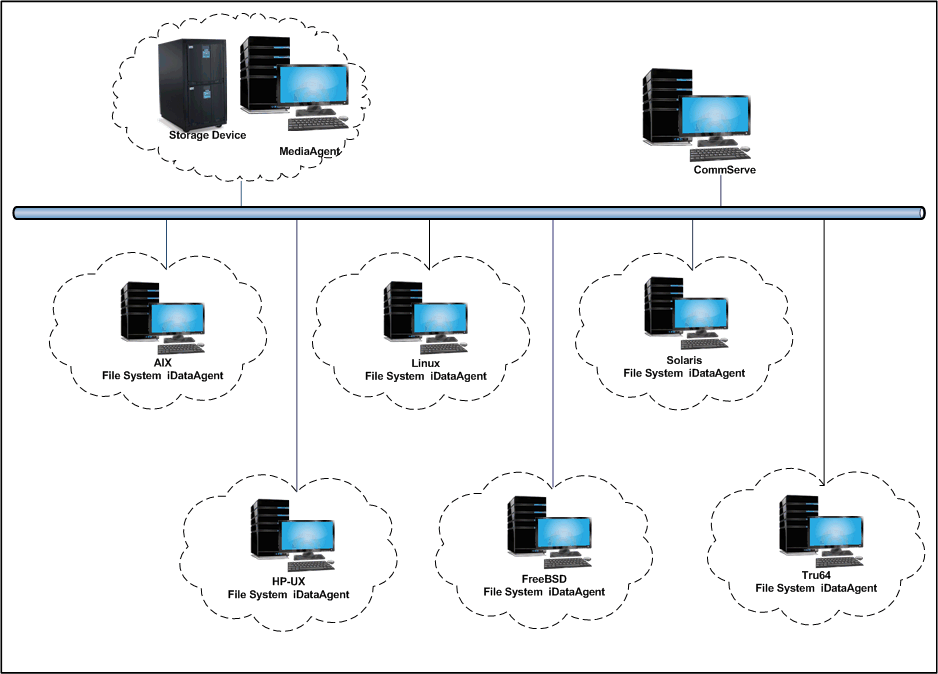
Table of Contents |
Where to go Next |
|
Walks you through the process of installing and configuring the File System iDataAgent for Linux. Walks you through the process of installing and configuring the File System iDataAgent for AIX Walks you through the process of installing and configuring the File System iDataAgent for FreeBSD. Walks you through the process of installing and configuring the File System iDataAgent for HPUX. Walks you through the process of installing and configuring the File System iDataAgent for Solaris. Walks you through the process of installing and configuring the File System iDataAgent for Tru64. |

In the event of a serious system failure, such as the breakdown of hardware, software, or operating systems, the Unix File System iDataAgent provides point-in-time recovery of files at any given time.
In the event that a MediaAgent used for the backup or recovery operation fails, it is automatically resumed on alternate MediaAgents. In such cases, the backup or restore job will not restart from the beginning, but will resume from the point of failure. This is especially useful for backups and restores of large amount of file system data.
In the event, that a network goes down, the backup and recovery jobs are resumed on alternate data paths. Similarly, in the event of a device failure, the jobs are automatically switched to alternate disk and tape drives.
You can view and verify the status of backup and recovery operations from the Job Controller and Event Viewer windows within the CommCell Console. You can also track the status of the jobs using Reports, which can be saved and easily distributed. Reports can be generated for different aspects of data management. You also have the flexibility to customize the reports to display only the required data and save them to any specified location in different formats. For example, you can create a backup job summary report to view at-a-glance the completed backup jobs.
In addition, you can also schedule these reports to be generated and send them on email without user intervention.
Deduplication provides a smarter way of storing data by identifying and eliminating the duplicate items in a data protection operation.
Deduplication at the data block level compares blocks of data against each other. If an object (file, database, etc.) contains blocks of data that are identical to each other, then block level deduplication eliminates storing the redundant data and reduces the size of the object in storage. This way dramatically reduces the backup data copies on both the disk and tapes.
SRM reports include detailed information on the state of your file system data, including free space, used space, file count, file sizes, directory structure, and many other useful statistics.
In addition, SRM summaries provide a graphical, real-time representation of usage information such as memory and CPU utilization. Optional file-level analytics provides even more granular details at the file-level for optimizing your storage resources.
SRM integration with UNIX File System iDataAgent can be easily enabled with your backups to take advantage of these features.
1-Touch recovery helps to recover a crashed system in the least amount of time. By automatically rebuilding the operating system, you can recover systems with defective components such as inaccessible volumes or crashed disks. You don't need to reinstall the individual software packages or operating systems manually.
The OnePass Agent is an integrated File System agent which backs up and archives the qualified data. It reclaims backup storage space when files and stubs are deleted on the primary storage.
Content Indexing and Search enables users to content index their data and later search the data from a user-friendly web interface. The users can also perform restore operations or other advanced actions on the searched data.
Desktop Browse enables users to browse and restore data from a Web Browser, which provides the facility to access and restore data from anywhere.
Client |
The computer in which the iDataAgent is installed and contains the data to be secured. |
Backup set |
A group of subclients which includes all of the data backed up by the iDataAgent. |
Subclient |
The Unix file system data to be backed up. |